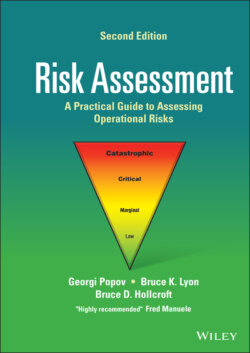Читать книгу Risk Assessment - Georgi Popov - Страница 19
1.3 Risk Assessment Methods
ОглавлениеOne of the purposes of this book is to present a variety of risk assessment methods and they are described throughout the text. For many hazards, the proper level of acceptable risk can be attained without bringing together complex teams of people. Safety and health professionals and design engineers having the experience and education can reach the proper conclusions on what constitutes acceptable risk. As defined in Z590.3, acceptable risk is:
Acceptable Risk. That risk for which the probability of an incident or exposure occurring and the harm or damage that may result are as low as reasonably practicable (ALARP) in the setting being considered.
ALARP – as low as reasonably practicable – is defined as that level of risk which can be further lowered only by an increase in resource expenditure that is disproportionate in relation to the resulting decrease in risk. (p. 12)
For the more complex risk situations, management should have processes in place to seek the counsel of experienced personnel who are particularly skilled in risk assessment for the category of the situation being considered. More complex risk assessment methods may be necessary in such situations.
Sometimes, for what an individual considers obvious, achieving consensus on acceptable risk levels is still desirable so that buy‐in is obtained for the actions to be taken.
It is suggested that the risk assessment method chosen fits the need. Sometimes, the method need not be complex. Information on a rather simplistic method follows. Its intent is to be illustrative.
Dated March 2020, NIOSH issued eNews Volume 17, Number 11, under the signature of the Director of NIOSH, Dr. John Howard. Its title is Using Science to Assess Workplace Hazards: NIOSH Practices in Occupational Risk Assessment. Content of this eNews follows:
What is Risk Assessment? Do you check for rain before deciding to carry an umbrella? Doing so is an example of risk assessment, which describes a process for answering three basic questions on a particular hazard.
What can happen? (It may rain today.)
How likely will it happen? (The Weather Channel says 70% chance of showers.)
What are the consequences if it happens? (I’ll be soaked without my umbrella.)
The answers provide a foundation for preventing or lessening the threat imposed by the hazard (e.g. carry an umbrella to avoid getting wet if caught in the rain) known as risk management.
One can take the position that NIOSH was overly simplistic. However, if a person follows the procedure outlined in the foregoing, that person has made a risk assessment.
